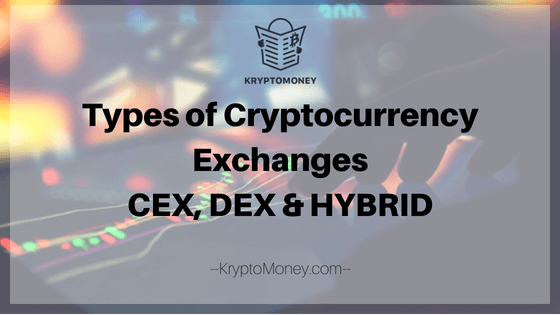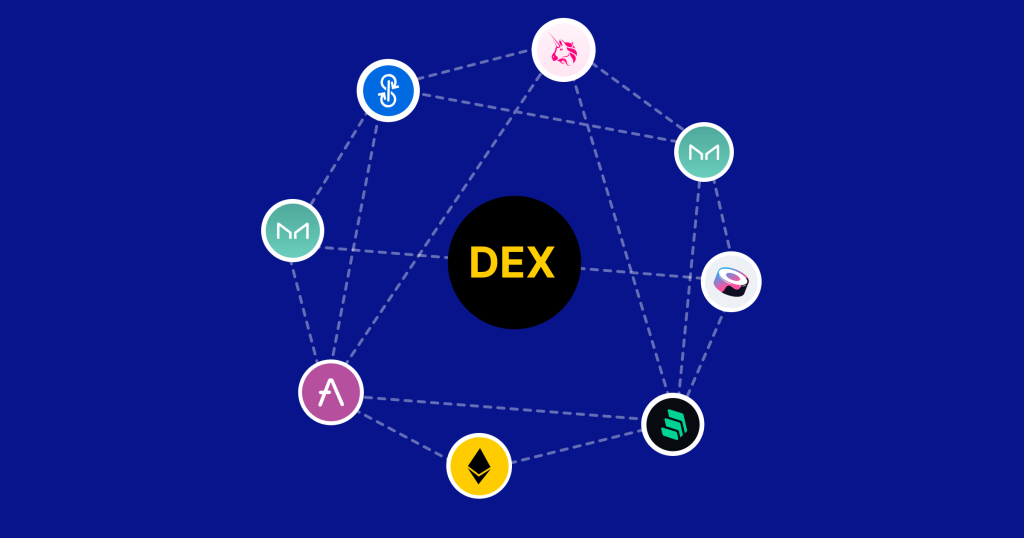Content Attributes

Cryptocurrency is a type of digital currency that is secured through cryptography and operates independently of a central bank. Crypto exchanges, on the other hand, are online platforms that allow users to buy, sell, and trade cryptocurrencies. There are three main types of crypto exchanges, namely centralized exchanges, decentralized exchanges, and hybrid exchanges. In this blog, we will take a closer look at these different types of crypto exchanges and their unique features.
Centralized Exchanges
Centralized exchanges are the most common type of crypto exchange. They are owned and operated by a central authority or a company that acts as an intermediary between buyers and sellers. Centralized exchanges require users to create an account and go through a verification process to ensure that they comply with Know Your Customer (KYC) and Anti-Money Laundering (AML) regulations. Once users have completed the verification process, they can deposit funds into their accounts and start trading cryptocurrencies.
Centralized exchanges have many advantages, such as high liquidity, a user-friendly interface, and a wide range of trading pairs. They are also more secure than decentralized exchanges since they have a central authority that can monitor and prevent fraudulent activities. However, centralized exchanges are also vulnerable to hacking and other security breaches, which can result in the loss of user funds.
Pros & Cons of Centralized Exchanges
Centralized exchanges (CEXs) are the most common type of crypto exchange. They are operated by a central entity that controls the platform, manages the order book, and matches buyers and sellers. In this blog, we will discuss the pros and cons of centralized exchanges.

Pros of Centralized Exchanges:
- High Liquidity: Centralized exchanges typically have higher liquidity than decentralized exchanges. This means that there are more buyers and sellers on the platform, which can lead to faster order execution and tighter spreads.
- User-Friendly Interface: Centralized exchanges often have a more user-friendly interface than decentralized exchanges. This makes it easier for users to navigate the platform and place trades.
- Advanced Trading Features: Centralized exchanges often offer more advanced trading features, such as margin trading, derivatives, and options. These features allow traders to leverage their positions and potentially increase their profits.
- Customer Support: Centralized exchanges usually have customer support teams that can assist users with any issues they may encounter while using the platform.
Cons of Centralized Exchanges:
- Centralized Control: The main disadvantage of centralized exchanges is that they are controlled by a central entity. This means that the platform is vulnerable to hacking, theft, and government regulation.
- Security Risks: Centralized exchanges hold user funds on their servers, which can make them a target for hackers. If the exchange is hacked, users can lose their funds.
- Privacy Risks: Centralized exchanges typically require users to provide personal information, such as their name and address, to use the platform. This can compromise their privacy and expose them to identity theft.
- High Fees: Centralized exchanges often charge higher fees than decentralized exchanges. This is because they have higher overhead costs associated with running a centralized platform.
Decentralized Exchanges
Decentralized exchanges, also known as DEXs, are a newer type of crypto exchange that operates on a peer-to-peer network. DEXs do not have a central authority or a company that acts as an intermediary between buyers and sellers. Instead, DEXs rely on smart contracts and blockchain technology to execute trades between users.
Decentralized exchanges offer several benefits over centralized exchanges. They are more secure since they do not have a central point of failure. They are also more private, as users do not have to go through a verification process or provide personal information. Additionally, decentralized exchanges are more transparent, as all trades are recorded on the blockchain and can be viewed by anyone.
However, DEXs also have several disadvantages. They have lower liquidity compared to centralized exchanges, which can make it challenging to execute large trades. They also have a limited range of trading pairs and a more complicated interface, which can be difficult for beginners to use.
Pros & Cons of Decentralized Exchanges

Decentralized exchanges (DEXs) have become increasingly popular in recent years as more and more people seek to trade cryptocurrencies in a decentralized manner. In this blog, we will discuss the pros and cons of decentralized exchanges.
Pros of Decentralized Exchanges:
- Decentralization: The main advantage of decentralized exchanges is that they are truly decentralized. This means that there is no central authority or entity controlling the platform. Instead, users have full control over their funds and transactions.
- Increased Privacy: Decentralized exchanges do not require users to provide personal information to use the platform. This means that users can maintain their privacy and anonymity while trading cryptocurrencies.
- Lower Fees: Decentralized exchanges typically charge lower fees than centralized exchanges. This is because they do not have the same overhead costs associated with running a centralized platform.
- No Single Point of Failure: Because decentralized exchanges are not controlled by a central entity, there is no single point of failure. This means that there is no risk of the platform being shut down or hacked by a single entity.
Cons of Decentralized Exchanges:
- Limited Liquidity: Decentralized exchanges typically have lower liquidity than centralized exchanges. This means that there may be fewer buyers and sellers on the platform, which can lead to longer wait times and higher spreads.
- Limited Functionality: Decentralized exchanges are still in the early stages of development and may not offer the same level of functionality as centralized exchanges. For example, some DEXs may only support certain cryptocurrencies or may not offer advanced trading features.
- Complexity: Decentralized exchanges can be more difficult to use than centralized exchanges. This is because they typically require users to interact with smart contracts and other technical components.
- Slower Transaction Times: Decentralized exchanges rely on blockchain technology, which can lead to slower transaction times. This is because transactions must be validated by nodes on the blockchain, which can take time.
Hybrid Exchanges
Hybrid exchanges are a combination of centralized and decentralized exchanges. They aim to offer the benefits of both types of exchanges while minimizing their drawbacks. Hybrid exchanges have a central authority that acts as an intermediary between buyers and sellers. However, they also use blockchain technology and smart contracts to execute trades, which makes them more secure and transparent.
Hybrid exchanges offer several benefits over centralized exchanges. They have higher liquidity and a wider range of trading pairs than decentralized exchanges. They also offer a more user-friendly interface and are more secure than decentralized exchanges since they have a central authority that can prevent fraudulent activities.
However, hybrid exchanges also have several disadvantages. They require users to go through a verification process, which can compromise their privacy. Additionally, they are still vulnerable to hacking and other security breaches, although to a lesser extent than centralized exchanges.
Pros & Cons of Hybrid Exchanges

In the world of cryptocurrency, there are three types of exchanges: centralized exchanges (CEXs), decentralized exchanges (DEXs), and hybrid exchanges. Hybrid exchanges, as their name suggests, combine the features of both CEXs and DEXs to offer users a unique experience. In this blog, we will discuss the pros and cons of hybrid exchanges.
Pros of Hybrid Exchanges:
- Best of Both Worlds: Hybrid exchanges combine the benefits of both centralized and decentralized exchanges. This means that users can enjoy the security and speed of a centralized exchange, as well as the privacy and control of a decentralized exchange.
- Greater Liquidity: Centralized exchanges are known for their high liquidity, which means that there are more buyers and sellers on these platforms. With a hybrid exchange, users can benefit from this liquidity while still maintaining control over their assets.
- Improved Security: CEXs are known for their high level of security due to the use of advanced encryption techniques and the presence of a centralized authority. Hybrid exchanges take advantage of this security while also offering users the added privacy and control of a DEX.
- Easy-to-Use Interface: CEXs are known for their user-friendly interfaces, which make it easy for even new users to navigate the platform. Hybrid exchanges typically offer a similar interface, which makes it easy for users to trade and manage their assets.
Cons of Hybrid Exchanges:
- Limited Decentralization: While hybrid exchanges offer some degree of decentralization, they are still centralized to some extent. This means that users do not have complete control over their assets, as they would on a fully decentralized exchange.
- Risk of Hacking: Hybrid exchanges are vulnerable to the same types of attacks that centralized exchanges are. This means that there is still a risk of hacking and theft, which can result in the loss of user funds.
- Regulatory Issues: Because hybrid exchanges are not fully decentralized, they are subject to the same regulatory issues as centralized exchanges. This means that they may be subject to government oversight, which can limit the types of assets that can be traded on the platform.
- Higher Fees: Hybrid exchanges may charge higher fees than fully decentralized exchanges due to the added security and functionality they offer. This can make it more expensive for users to trade on these platforms.
Conclusion
In summary, there are three main types of crypto exchanges: centralized exchanges, decentralized exchanges, and hybrid exchanges. Each type of exchange has its own unique features and benefits. Centralized exchanges offer high liquidity and a user-friendly interface, but they are also more vulnerable to security breaches. Decentralized exchanges are more secure and private, but they have lower liquidity and a more complicated interface. Hybrid exchanges aim to offer the benefits of both types of exchanges while minimizing their drawbacks. Ultimately, the choice of exchange depends on the user’s preferences and their level of experience in trading cryptocurrencies.
Also Read:
- What is a Cryptocurrency Exchange & Minimizing the Cost?
- A Decentralized Crypto Exchange Eliminates the Role of Intermediaries
- A Complete Guide To Create A Crypto Exchange Software
- Explore New Benefits from Downloadable Healthcare Apps
- Virtual Photo Booth-A Powerful Solution for Hybrid Events